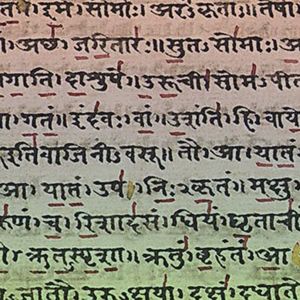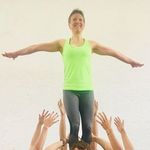
Sabine: Barbara, it's by no means the case that you've been an enthusiastic yogini for your entire life. In contrast, when you started your sports career you were a passionate outdoor athlete. How did you discover yoga for yourself?
Barbara: During my childhood, the topic "top performance in sports" was quite dominant. At the Olympic Games in Squaw Valley in 1960, my aunt was the most successful German athlete (downhill, giant slalom) and my mother was also a member of the German national skiing team.
I, too, was highly active in sports. However, due to a congenital hip dysplasia, I regularly suffered from pain even at a very young age when performing in my focus disciplines skiing and tennis. Already at the age of 26, my doctors advised me to have an operation on both hips. They were sure that I would otherwise end up in a wheelchair in the medium run. A strong inner voice and the fear of a complicated operation made me decide against this option, though. When I discovered sport climbing and other outdoor sports for me, I found a new perspective for myself and the pain eased.
At this point, I did not have any connection to yoga whatsoever. This changed when I by chance met a 98 year old yoga teacher during a short trip with my family who triggered my interest in yoga. Already in the first class with her, I discovered a new level in the performance of a movement. Moreover, the great mental clarity and unconditional flow of breath immediately convinced me. This was the beginning of my yoga path.
Sabine: What came next and what was it that ultimately brought you to AYI®?
Barbara: What followed were many different yoga classes as well as workshops and trainings with renowned yoga teachers (Barbara Noh, Gabriele Bozic, Dr. Patrick Broome, Yogeswari, David Life & Sharon Gannon, Michael Hamilton, David Swenson, Tim Miller). They shaped my further development until about four years ago. Moreover, 20 years after the initial diagnosis and 12 years after my first yoga class, I am now completely free from pain. Without having undergone any operation.

We thank Stefan Schütz for the pictures on this page.
www.stefanschuetz.com
My own classes started 15 years ago, when, after the birth of my children and next to my job as a qualified sports economist, I began to teach courses for people with back problems. Back pain prevention turned into body & soul. And body & soul turned into yoga. Thus, step by step, my classes gradually developed a more and more holistic focus.
The number of yoga students continued to grow and after some years' experience as a yoga teacher, I realized that I wanted to gain a deeper understanding of yoga. With our move from the Bavarian foothills of the Alps to Lake Constance, I was confronted with the decision of whether to return to my old job or to focus more seriously on my part-time job as a yoga teacher. Since I frequently act highly intuitively, I once again followed an inner voice which told me not to send in my job application documents for sports marketing, which I'd already put together. Thus, I searched for information on how I could progress on my way as a yoga teacher instead.
One aspect that was of particular interest to me in this context was yoga therapy. I therefore wrote to a number of renowned yoga teachers in this field. Only one day after my e-mail, I got a reply from Dr. Ronald Steiner. "Wow!" was my first thought when I read: "You're more than welcome."
This decisive contact with Ronald - a wonderful teacher - has continued to shape and inspire my development up to where I stand right now.
Sabine: You have recently completed your AYI® Advanced training. What does teaching mean to you?
Barbara: With finishing the AYI® Advanced Training in April 2016, a small dream has come true. When I started teaching yoga over 10 years ago, I considered teaching a minor hobby. Today, yoga has become an integral part of my life. It has found its own place and, other than at the beginning, is no longer merely practiced but lived.
Starting the yoga school "Ashtanga Yoga Konstanz" was by no means something I had planned from the start but rather something that more or less happened. I like to let myself drift, to see what will come. Some people around me but also some of my students try to follow a quite detailled life plan and when some expectations are not met, they are disappointed.
Sabine: What is especially important to you when you're teaching? What is it that you want to pass on to your students?
Barbara: For me it's especially important that students leave my class with a positive feeling. I always want them to feel that I'm there for them, that I'll guide them on their way and that I can empathize with them. I place great importance on keeping an individual focus on each student. Precision and alignment, coupled with a lot of sensitivity for the mental attitude, this is what I try to impart in all of my classes. In yoga, we're all constantly undergoing change. There's nothing that's perfect but only a continuous process.
Over the last ten years of teaching, I have always grown with my students - and they probably also with me. In doing so, I don't follow a pre-defined goal but I want to achieve something. Everybody should get the chance to get to know themselves better. From my daily experiences on the yoga mat, focus topics develop on which we start to work in our classes each week. These range from anatomical topics to philosophical aspects. Last week, for instance, we focused on "Mental Alignment", i.e. the inner attitude or turn away from an external image.
Sabine: At Ashtanga Yoga KN, you by now use the AYInnovation® Method for all classes. Why have you opted for this method and what, in your eyes, are its decisive features?
Barbara: Our masters such as Krishnamacharya or Pattabhi Jois taught traditional Ashtanga Yoga. Their students were very young, hardly any over 30 years old.
With AYI®, we want to meet people of all ages where they stand, with all their individual mental and physical abilities and preconditions. We are convinced that everybody can find access to the depth, possibly even "healing power", of Ashtanga Yoga.
The students at Ashtanga Yoga KN are between 19 and 75 years old. Some of them suffer from physical conditions such as arthrosis or chronic back pain, others have been afflicted with depressions for years. Especially those students regularly tell me how their pain or ailments could be reduced to a minimum.
I, personally, am happy when I can do something from which other people benefit. The fact that some of my students have been with me for more than seven years now makes me feel positive and of course it also motivates me to carry on.
The AYI® Innovation Method allows me to realize own ideas which gives me as a teacher a certain freedom. Thus, next to classic Ashtanga workshops such as Pranayama, Philosopy or Ashtanga Intensives, we have recently also started offering workshops or retreats that integrate other meditative aspects (e.g. walking meditation or movement meditation). "Ashtanga Yoga & Hiking“, for instance, is now an established part of our workshop program, "Yoga & Creativity“ a pilot project. It gave us incredible pleasure to see how the participants first got into the flow via breathing and body work and then without interruption moved on to painting, which was guided by a very experienced instructor for art therapists.
'' Sabine: To finish our interview, I'd like to once again come back to you and your own practice. One sentence that has especially inspired you comes from Patañjali's Yoga Sūtra, to be more precise I.50. Why have you chosen precisely this passage and what do you associate with it?
Dein Gehirn ist trainierbar. Jede Erfahrung, die Du einmal machst, wird leichter zu wiederholen. Das trifft sogar auf die Wesenskern-Erfahrung (samādhi) zu. Sie hinterlässt eine Prägung in Deinem inneren Wahrnehmungsraum, die andere Prägungen überschreibt.
Dr. Ronald Steiner - modern transfer
Die aus diesen [geistigen Objekten] entstandene (taj-jaḥ | nom sg) Prägung (saṁskāraḥ | nom sg) [führt zur] Unterbindung (pratibandhī | nom sg) von anderen Prägungen (anya saṁskāra | tp gen).
Dr. Ronald Steiner - historic word by word translation
Der aus dieser [höhern Art der Erkenntnis] erzeugte Gemütseindruck hält die andern Gemütseindrücke nieder.
Paul Deussen - 1908
The train (of self reproductive thought) resulting from this puts a stop to other trains.
James R. Ballantyne - 1852
Barbara: This decisive sentence has inspired me to continue my yoga path further. It unites everything. All sentences before finally lead up to I.50. Breaking out of the patterns that previously shaped me, to leave them behind one day in order to start a new trace - that's what fascinates me. Cleansing my old consciousness so as to make room for a new consciousness, possibly even transformation, gives me incredible motivation.
However, I by no means aim to become a new person. In contrast, what I'm after is development or growth. This is also reflected in my yoga practice: what started out as a quite goal-orientated practice has over the years become a much softer and more gentle practice. At the moment, I'm practicing the Second Series. But when I don't feel like it, I also practice positions from the Second or Third Series. Or the First Series with modifications which are good for my body.
In following the inner stream of life, the paragraphs YSI.23-26 have been very helpful to me. Since iśvara has been accompanying me on my way in life, a lot has changed. Iśvara takes over part of the responsibility. He also helps me when it comes to maintaining a global perspective on the universe so as to forget the small sorrows of everyday life. My "personal God" guides me on longer hikes through the mountains or helps me in situations which require strong nerves. I can feel how he helps me follow my own instincts to make decisions.
Sabine: Thank you so much for the interview and for sharing such personal impressions and experiences with us!
AYI® Morning Practice im Zeitraffer. Lass Dich inspirieren!
„Entstanden ist unser kleiner Yogafilm eher spontan, ohne das ganze Drumherum wie Visagisten oder Assistenten - nur Stefan, der Kameramann und ich. Wir haben uns für einen Film entschieden, denn ein bewegtes Bild ist immer unverfälscht, authentisch. Der Clip soll Yogis motivieren, die Matte auszurollen und den Flow und die Balance zum Ausdruck bringen, die entstehen kann, wenn man regelmäßig praktiziert.“



 Dr. Sabine Nunius
Dr. Sabine Nunius
 Barbara Kittel Holmgren
Barbara Kittel Holmgren
 Dr. Ronald Steiner
Dr. Ronald Steiner




 Barbara Kittel Holmgren
& more
Barbara Kittel Holmgren
& more

